Hydraulically integrated serial turbidostat algal reactor system in beta testing
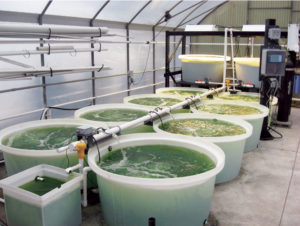
According to the United Nations Food and Agriculture Organization, by 2030, both freshwater and marine aquaculture will need to expand production an additional 28.8 million metric tons per year just to maintain current per-capita seafood-consumption levels. A major technological bottleneck in the expansion of the marine aquaculture industry remains the lack of commercial hatchery technologies to support the growout industry.
The inability to supply large quantities of microalgal/zooplankton feeds cost-effectively and consistently continues to be a major limitation for the marine aquaculture industry. Marine aquaculture research has shown that invertebrates and fish larvae reared on live feed exhibit better growth and survival.
Prevalent culture techniques
As the need for microalgae increases, semicontinuous and continuous cultures are becoming the prevalent culture techniques. Most continuous cultures of microalgae are implemented within totally enclosed bioreactors to minimize airborne contaminant introduction and increase system control. But since continuous cultures tend to be operated over a much longer time than the typical batch culture, the potential for contamination is significantly greater. The inadvertent introduction of undesired microalgae or zooplankton into a culture eventually leads to competition within the reactor and the eventual collapse of the desired microorganism.
Economical, large-scale microalgal culture designs must therefore mesh “contaminant tolerance” and contaminant mitigation with productivity requirements.
HISTAR system
Some years ago, Dr. Kelly A. Rusch at Louisiana State University developed the Hydraulically Integrated Serial Turbidostat Algal Reactor (HISTAR) to provide a robust system that superimposes contaminant control techniques on a continuous algal production system. Starting in 1999, Aquaculture Systems Technologies, LLC pursued the commercial potential for HISTAR to provide an efficient and cost-effective system for the commercial production of microalgae to support freshwater and marine aquaculture.
Aquaculture Systems Technologies realized that although the research system could be commercially competitive, further refinement would result in lower capital and production costs. Development of HISTAR systems capable of productivity levels at production costs of less than U.S. $60/kg dry weight of algae would make this technology an attractive alternative to current strategies.
In 1999, Aquaculture Systems Technologies received a Phase I Small Business Innovative Research grant from the United States Department of Agriculture to demonstrate the feasibility of this technology operated under greenhouse conditions. After successful completion of Phase I, a Phase II grant was received to focus on further testing of the system and the development of design and operational guidelines for commercialization.
Continuous algae production
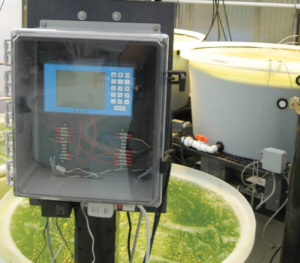
analog inputs and eight control relays.
HISTAR combines the use of turbidostats/chemostats with open-top, continuous-flow stirred-tank reactors (CFSTRs) and process control to produce a continuous supply of a microalgae culture. The turbidostats are completely enclosed to prevent contamination and produce a continual algal inoculum of high and consistent quality for the series of hydraulically linked reactors, which are open to the atmosphere.
By using the enclosed turbidostats as an inoculum source and not for production, their volume can be kept small relative to the rest of the culture system. This reduces the amount of pristine source water required. Microalgae periodically harvested from the turbidostats flow into the first of a series of eight continuous-flow reactors to maintain the desired biomass density. A continuous flow of water with added nutrients into the first CFSTR is the primary driving force for serial flow through the system.
This flushing flow, combined with the turbidostat flow, is manipulated to maintain the desired local dilution rate. This dilution rate is selected to be substantially higher than the net specific growth rate of contaminants to assure contaminant washout from individual CFSTRs before significant growth can occur. Thus, even though contaminants may grow extremely fast within the culture, they are washed to the next reactor before exponential growth occurs.
Eventually they are washed out of the last CFSTR. The target algal species, however, is not washed out because it is semicontinually inoculated into the first CFSTR from the turbidostats. Continuous flow of algae through the CFSTRs provides time for the microalgal culture to grow under optimal conditions.
This combination of continual input of desired algae from the turbidostat to the first CFSTR, the high dilution rate of the individual CFSTRs and low system dilution rate provides an environmental advantage to the desired algae while flushing out any contaminants. An additional advantage is the continuous harvesting of microalgae even during periods of low to no light due to the continual input of algae into the first CFSTR from the turbidostats, which receive supplemental artificial illumination.
Prototype commercial system
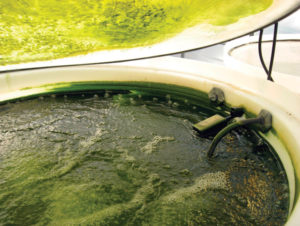
After major interruption of this research by Hurricane Katrina, a commercial prototype system was constructed in the summer of 2008 in a greenhouse at Aquaculture Systems Technologies in New Orleans. The HISTAR system design was considerably simpler than the original research system to reflect changes in available commercial monitoring and control systems, and operational and management experience.
The HISTAR systems consists of six major components: two enclosed turbidostats and eight round, serial-linked 473-liter CFSTRs, an air injection system, a carbon dioxide injection system for pH control, a nutrient injection system, lighting systems for the turbidiostats and an automation and monitoring system.
The turbidostats operate as continuous cultures and provide a continual supply of inoculum for the CFSTRs. As with any type of live-cell culture, exposure to contamination is a major issue of concern, and this is particularly true for the nonsterile environment in which the HISTAR system is designed to operate. Consequently, two turbidostats provide a backup source in the event of inadvertent contamination of one or the other. The use of two turbidostats also facilitates taking one offline for cleaning without interrupting system operation.
Filtered and ultraviolet-sterilized air is used to keep the culture completely mixed and maintain positive pressure in the turbidostats to reduce contamination. Artificial lighting supplements the natural light available in the greenhouse setting for the turbidostats only. The turbidostats are raised above the CFSTRs to allow the algae inocuum to flow by gravity into the first CFSTR.
To prevent nutrient limitation, nutrients are added continuously in excess through the nutrient injection system. An enriched medium is kept in two 57-liter tanks to keep the macronutrients and micronutrients separate. The nutrients are maintained at a pH level of 2 to prevent contamination. The two components are mixed by separate injections into the treated source water/nutrient line.
To prevent contamination, the source water is treated before entering the system by a prefilter, two activated carbon filters and a 45-watt ultraviolet sterilizer in series. The system is monitored and controlled by an industrial process control computer with eight analog inputs and eight control relays. System pH is monitored with two industrial-grade pH probes, and carbon dioxide is injected as needed to maintain a stable pH.
Real-time algal biomass density in the two turbidostats and the final CFSTR is monitored with transmisiometers that correlate light transmittance to total suspended solids. These values are then used to calculate and control the biomass of algae harvested from the turbidostats. Microalgae are harvested from each turbidostat every 20 minutes, resulting in microalgal transfer to the first CFSTR every 10 minutes. Microalgae from the final CFSTR are finally concentrated into a paste using a centrifuge.
HISTAR status
The HISTAR system is currently going through trials, growing Selenastrum capricornutum and debugging the process control software and harvest algorithm. One beta system has been delivered for field evaluation, and a second is being constructed for delivery in early 2009. With Phase I funding from the National Science Foundation, Aquaculture Systems Technologies is also currently developing a continuous-culture system for the production of s-type rotifers.
(Editor’s Note: This article was originally published in the January/February 2009 print edition of the Global Aquaculture Advocate.)
Now that you've reached the end of the article ...
… please consider supporting GSA’s mission to advance responsible seafood practices through education, advocacy and third-party assurances. The Advocate aims to document the evolution of responsible seafood practices and share the expansive knowledge of our vast network of contributors.
By becoming a Global Seafood Alliance member, you’re ensuring that all of the pre-competitive work we do through member benefits, resources and events can continue. Individual membership costs just $50 a year.
Not a GSA member? Join us.
Authors
-
Paul Hightower
Aquaculture Systems Technologies, LLC
108 Industrial Avenue
New Orleans, Louisiana 70121 USA -
Douglas Drennan II
Aquaculture Systems Technologies, LLC
108 Industrial Avenue
New Orleans, Louisiana 70121 USA -
Kelly A. Rusch, Ph.D., P.E.
Department of Civil and Environmental Engineering
Louisiana State University
Baton Rouge, Louisiana, USA
Related Posts
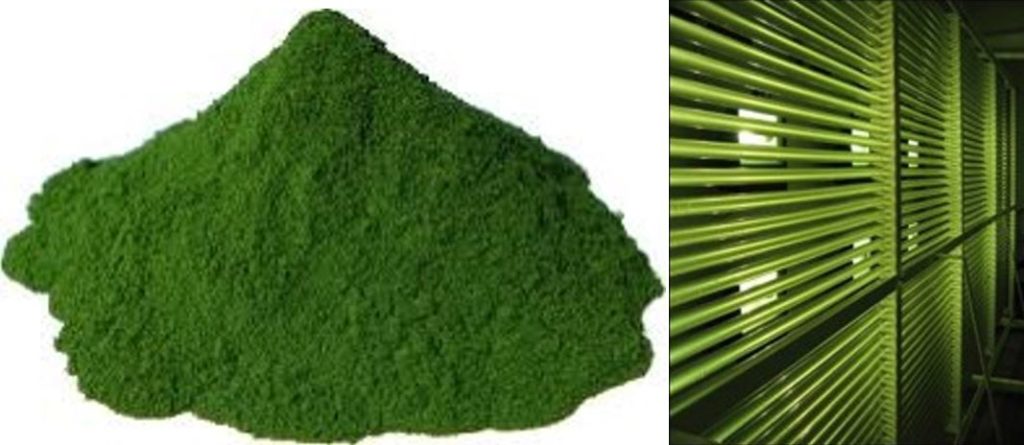
Aquafeeds
Evaluating Nannochloropsis-based feeds for tilapia
This study assessed the efficacy and nutritional properties of the marine alga Nannochloropsis salina as a feed ingredient using tilapia (Oreochromis niloticus) as a model species. Results showed adequate growth, survival, FCR and enhanced EPA levels.
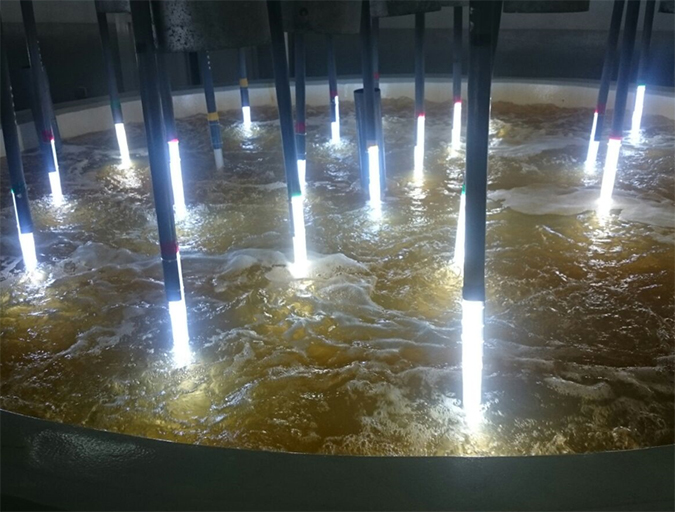
Aquafeeds
Novel light bank reactor aids in microalgae culture
The control of temperature and light intensity in microalgae culture in outdoor tanks is difficult. Progress in algal biotechnology and the use of photo-bioreactors, metabolic engineering and other advances supported development of a novel underwater light bank reactor that allows for more effective light utilization by cultured microalgae.
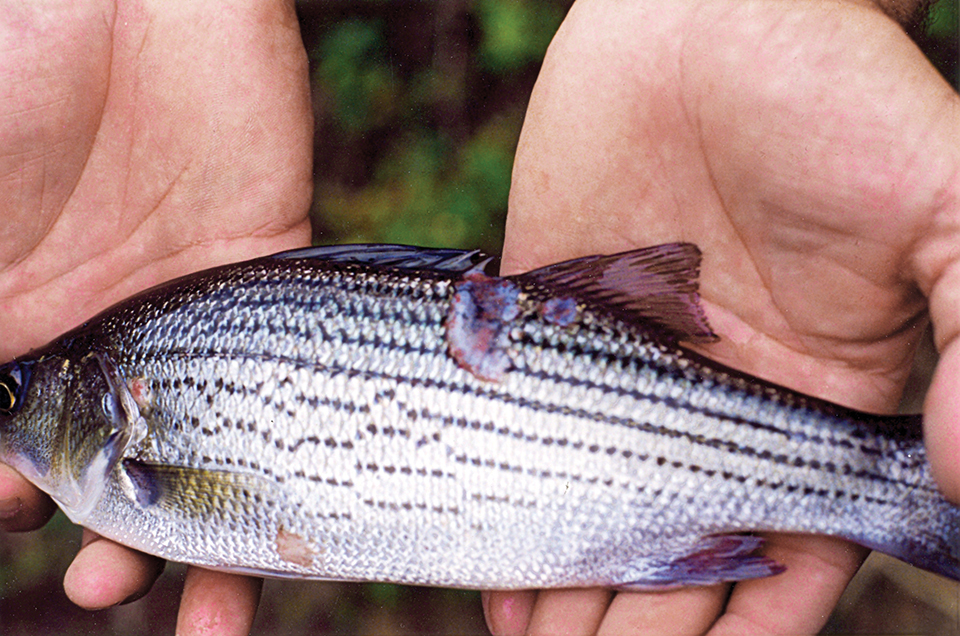
Health & Welfare
Antibiotic-resistant bacteria, part 1
No antimicrobial agent has been developed specifically for aquaculture applications. However, some antibiotic products used to treat humans or land-based animals have been approved for use at aquaculture facilities.
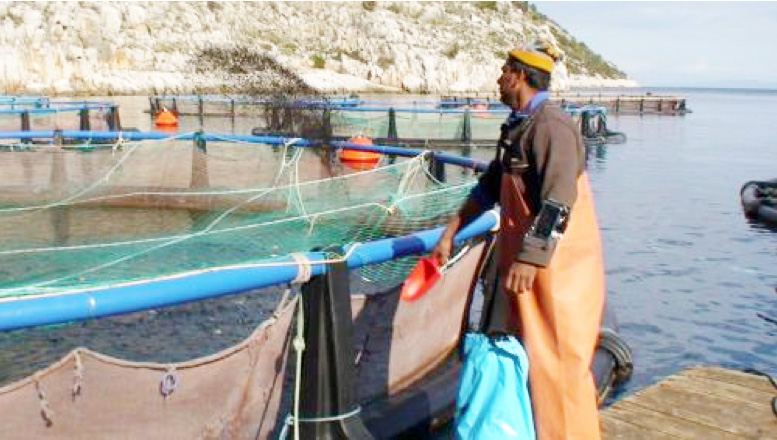
Innovation & Investment
Data-driven management technology can transform aquaculture
Aquaculture is a complex industry, but extensive knowledge of its varied facets exists. While the resources required for aquaculture face limitations, production efficiencies are improving. Today’s industry needs better information-based management strategies to increase its performance and sustainability.


